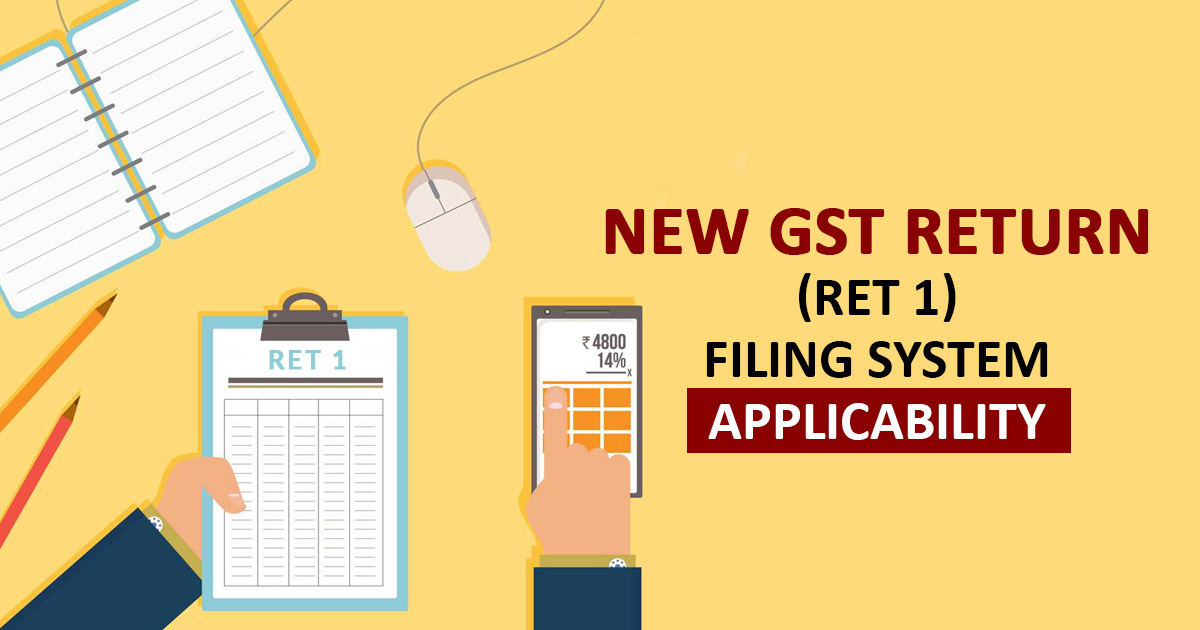
The resurgence of GST mechanism marks the beginning of the trial phase for the same. With the desideratum to make the taxpayers well-acquainted with the revamps introduced in new GST return system, the trial period has been fixed by the Finance Minister.
Note: The FM has announced the RET 1 applicability and approved it in the 35th GST council meeting.
The whole plan has been rolled out by the Finance Minister, and the period from July to September has been finalised as a Trial period. The return form (Form GST RET-1) and two annexures (Form GST ANX-1 and Form GST ANX-2) are the three key components of the new return process. The return has been simplified by the government and the draft of the same has also been released along with some offline utilities.
Annexures
FORM GST ANX-1 includes all the details of complete outward supplies, inward supplies on a reverse charge basis and import of goods and services to be included invoice-wise (except for B2C supplies) on a real-time basis.
FORM GST ANX-2 includes all the details of inward supplies while the recipient can reject or accept these documents, or tick them as pending, for further concern.
New GST Return Due Date Applicability for Taxpayers
Current Update related to GST return filing system dated 14 March 2020
Implementation of new and modified GST return system from October 2020.
The current GST return filing system (GSTR 1, 2A and 3B) is operational until 30 September 2020.
According to the notification released by CBIC:
As per the conclusions driven by the 37th GST Council meeting (held on 20 September 2019), the commencement of the new GST return system and the amended forms for the entire taxpayer accumulation in India were postponed till April 2020 against the earlier October 2020.
Simplified Returns and Its Benefits
The simplified returns under GST first came into limelight after the 31st meeting of GST Council. The simplified return mechanism is completely built as per the concept of a single return. Even the frequency of filing the same will also depend on the entity’s generated turnover
Simplified returns under GST has various benefits over the previous model and that’s why some of the benefits of simplified returns are engraved below which show you how its inclusion into the system is necessary to progress:
- These are profile-based returns. There are various supplies that come under the periphery of GST, but there are many dealers who deal with only a few supplies. Hence, a specific profiling questionnaire will allow the GST return format to display only the relevant information fields that suit the taxpayer’s profile.
- In this new system, the supplier can upload invoices on a continuous and real-time basis, The same will be available for the recipient to take an action such as acceptance, reject and hold.
- The forms and filing procedure became simplified which will save something from the compliance costs.
- Now, taxpayers will be allowed to do correction in their returns once filed, they can now also file up to two revised returns for a tax period.
Frequency of Filing FORM GST RET-1
Now a normal taxpayer who is making B2B supplies, B2C supplies, inward supplies that attracts reverse charge mechanism, NIL or zero-rated or supplies through e-commerce operators are eligible to file GST RET-1.
Large taxpayers having turnover more than Rs 5 crore in the previous Financial Year will have to file GST RET-1 return on a monthly basis. Similarly, small taxpayers having turnover up to Rs 5 crore in the previous financial year can file the return quarterly.
What are the Changes?
GST return system has come back with some changes which include the replacement of GSTR 1 with Form GST ANX and GSTR-3B with Form GST RET-1. The taxpayers will now use Form GST ANX instead of GSTR 1. Since the trial period will last till September, the large taxpayers whose total annual turnover in the previous fiscal period exceeds ₹5 crore, will have to start using Form GST ANX from October while the small taxpayers whose total annual turnover in the previous fiscal year was up to ₹5 crore, will have to use Form GST ANX in January as they file returns on a quarterly basis and will file return for the October-December quarter.
As far as Form GST RET-1 is concerned, all the taxpayers will have to start using this Form, from January.
Starting From July 2019
From July, under the trial, users may upload invoices using the GST ANX-1 offline tool as well as view and download the inward supply invoices through the GST ANX-2 offline tool. The details of inward supply invoices will be present in summarised form for access on the common online portal.
In addition, from August, users may import their purchase register in the offline tool and compare the same with the downloaded inward supply invoices to ascertain the disparities.
From July-September 2019
The July-September has kept as a trial period for taxpayers to acclimate them with the new return system and this is the sole motto behind this. It has nothing to do with the tax liability or input tax credit of the taxpayer, neither it is going to leave any impact on them. The taxpayers will simultaneously file existing return forms (GSTR-1 and GSTR-3B) in this trial period and if they fail to do so, they will be under obligation to pay penalties and interests under the standard norms.
Starting From October 2019
From October, the stringent rules will come into action in a full-fledged way. It will become mandatory to substitute the return GSTR-1 with monthly GST ANX-1 from October for large taxpayers and with quarterly GST ANX-1 from January 2020 for small taxpayers for the quarter period of October-December 2019.
After the trial period, the large and small taxpayers may upload invoices in GST ANX-1 on a regular basis, while GST ANX-2 will be available to be viewed only.
From October, small taxpayers will begin filing GST PMT-08 and end filing GSTR-3B. The first GST RET-01 for the quarter October-December will be filed from January 2020 by the small taxpayers. For the large taxpayer, the first GST RET-01 for December will be filled by January 2020 and they will persist filing GSTR-3B on a monthly basis
Parag Mehta who is a partner at NA Shah Associates LLP feels that the new return forms are not much simple and easy where the user will need to upload GST ANX-1 mentioning their outward liability, imports as well as inward supplies sprouting reverse charge.
“Based on GST ANX-1, filed by all, businesses will be able to download details of auto-drafted inward supplies in GST ANX-2, he said.
“The trade will be required to accept, reject or keep in pending the ITC on inward supplies. After completion of GST ANX-2, an auto-populated return in GST RET-1 will be generated. All the activities will have to be done on a monthly basis,” he added








